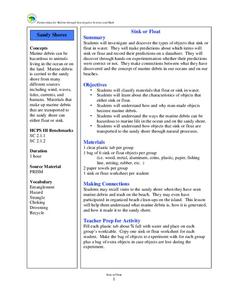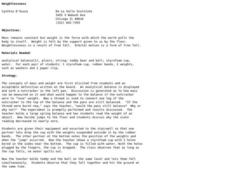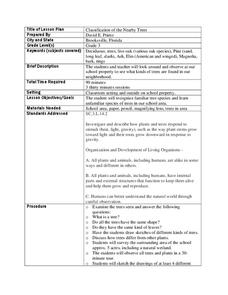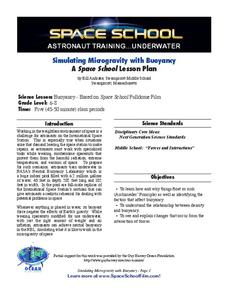Curated OER
An Invisible Pull
Fifth graders explain why objects thrown upward falls back to Earth. In this earth science lesson plan, 5th graders identify the forces acting on objects. They discuss why planets do not float in space.
Curated OER
Pendulum Activity
Fourth graders conduct a lab activity that measures the factors that change the swing rate of a pendulum. They create a hypothesis and test it during the experiment. They record their observations using the recording sheets and journal...
Curated OER
Strawkets and Control
Students investigate the effect that fins have on rocket flight. They construct two paper rockets that they can launch by blowing through a straw, one with fins and one with wings, and observe and record the results of the rocket flights.
Curated OER
Simple Machines I - Inclined Planes, Wedges, and Screws
Fourth graders examine the physics behind and uses for inclined planes, screws, and wedges. They determine examples of how these simple machines are used in daily life. Working in three small groups, they move from station to station...
Curated OER
Life in Space: International Space Station
Students explore the potential challenges of living in space. In this investigative lesson plan students search the Internet to locate 16 nations that are working together to build the Independent Space Station, then they divide...
Curated OER
Sink or Float
Students explore water properties by conducting a class experiment. In this buoyancy lesson, students make predictions as to whether or not specific objects will sink or float in water. Students conduct the experiment and record their...
Curated OER
Weightlessness
Young scholars compare and contrast the terms "weight" and "mass". In this physics lesson, students observe an experiment in which objects are placed on a balance scale and weighed under different circumstances. Partners drop items and...
Curated OER
Analyzing Motion of a Tossed Ball
Students investigate the parameters involved with launching a basketball at an angle. In this motion lesson students predict and sketch graphs that show the motion of a ball toss.
Curated OER
Physics: Forces and Motion
Learners recognize the effect of Earth's gravity on an object's weight. In this force and motion lesson students understand the role of gravity when you drop an object. Learners experiment with small items. Students measure in Newton's....
Curated OER
Tropism
Students conduct various experiments on tropism. In this biology lesson, students explain how gravity affects the growth of plant roots. They identify the different types of tropisms.
Curated OER
Paper Towers
Students have the opportunity to use model-building as a way to help comprehend the forces and phenomena at work in the world around them. They describe gravity as a universal force that pulls everything toward the center of the earth....
Curated OER
Classification of the Nearby Trees
Third graders practice using classification techniques to identify local trees. In this plant life instructional activity, 3rd graders discuss how trees differ from other plants and what characteristics are unique to trees alone....
Curated OER
Animal Behavior
Students investigate stimulus-response behavior, learned behavior in animals and innate behavior in animals. In this animal behavior lesson plan, students answer questions about their reactions to a toy cap gun that is fired off in...
Curated OER
Periodic Motion - The Pendulum
Students study the concept of periodic motion and relate it to the movement of a pendulum. They discover that the period of a pendulum is dependent on the length of the pendulum and independent of the bob and the amplitude.
Curated OER
Where We've Been and Where We're Going
Students travel with Christa McAuliffe through space demonstrations. In this space lesson, students follow through the past to the present air travel. Students understand the benefits and problems associated with zero gravity and how it...
Curated OER
Energy: The Universal Currency
Science stars examine the concept of energy by thinking about everyday situations. The lesson plan is incohesive. It lists goals for the student, but doesn't address all of them in the content. The best use of this resource would simply...
Curated OER
Structure and Function of Vertebrates - Reading/Notetaking Guide - Amphibians
A variety of questions are presented on the amazing amphibian. Life science intellectuals complete a life cycle diagram, describe characteristics and behaviors, and fill in a metamorphosis flowchart. Content level is geared toward middle...
Curated OER
Is There a Tenth Planet?
In this planets worksheet, students read about how our solar system's planets were discovered and how scientist believe there might be a tenth planet. After reading, students complete 4 short answer questions.
Space Awareness
Model of a Black Hole
Even light cannot leave the force of a black hole! Learners use a model to explore the gravitational force of a black hole. An elastic bandage and heavy ball serve to create the hole, while marbles become the victims of its strong force.
K12 Reader
Why Does the Moon Orbit Earth?
Have you ever looked up at the moon and wondered why it looks different every night? Learn about the moon's orbit and the lunar cycle with a reading comprehension exercise. Using context clues, kids find the definitions of unfamiliar...
PBS
Zip Line
Slide all the way to the bottom. Using the design process, pupils create a carrier for a ping pong ball that will travel down a zip line. Learners test their carriers and determine solutions to issues they encounter to complete the third...
K5 Learning
The Sun and the Stars
How are the stars similar to the sun in our galaxy? Learn all about the solar system with a reading excerpt about the sun and the stars. Kids read an informational passage before they answer questions about reading comprehension,...
Florida International University
Simulating Microgravity with Buoyancy
How do astronauts know how to live and work in a weightless environment? It doesn't come naturally! Junior physicists conduct experiments to examine the link between buoyancy and microgravity. Each activity illustrates a different aspect...
Cornell University
Alka-Seltzer Rockets
Blast off! An engaging hands-on activity has pupils create rockets powered by Alka-Seltzer. They learn about the physics behind these rockets throughout the process.























